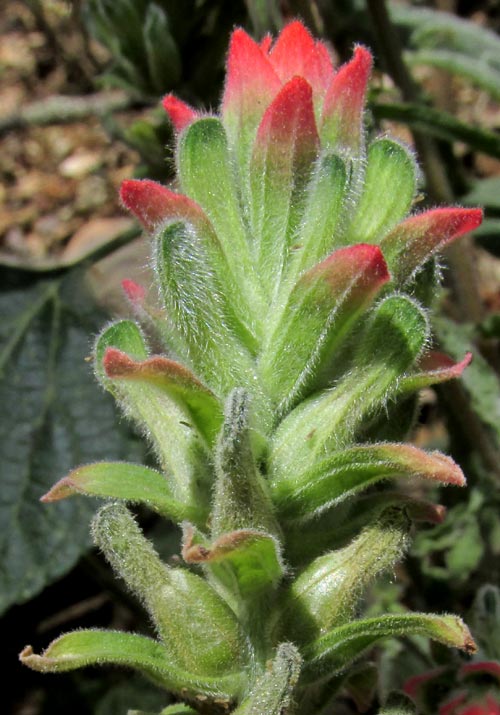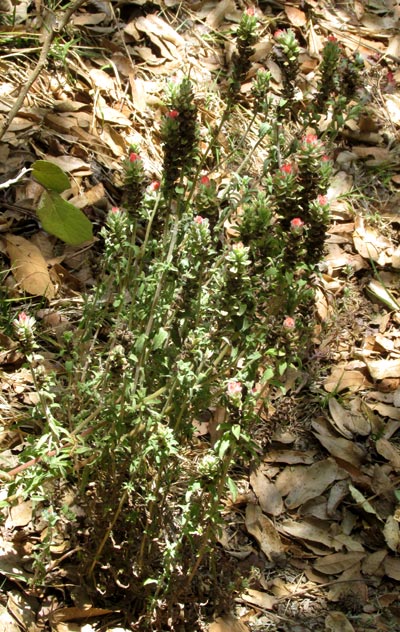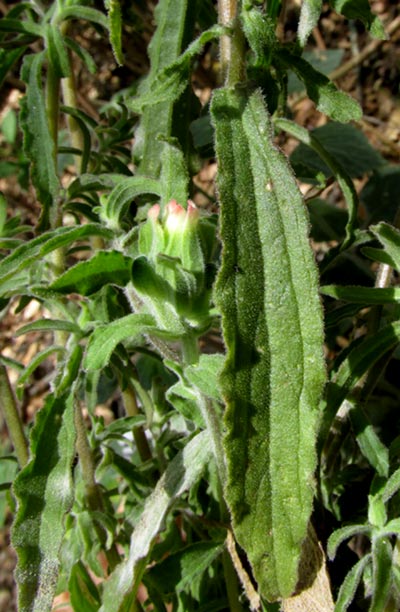Excerpts from Jim Conrad's
Naturalist Newsletter
entry from field notes dated April 15, 2022, taken in disturbed/reforesting borderline cloudforest within 1km of Valle de los Fantasmas, elevation ±2,320m (7600 ft), with limestone bedrock; about 40kms (24 miles), straight-line, ESE of San Luis Potosí, San Luis Potosí state, MÉXICO, (N22.06°, W100.62°)
FIELD INDIAN PAINTBRUSH

Emerging from a deep litter of late-dry-season crispy-brown leaves in the bottom of a shallow sinkhole in a wooded area, a weedy looking plant was tipped with what's shown above. The red parts aren't flowers but rather bracts, which are modified leaves. Still, this is a flowering head, or inflorescence.
The red-tipped bracts arise below green, hairy flowers in various stages of maturity. At the inflorescence's very top you see only red-tipped bracts. At the picture's center, each bract arises below a hairy, round-tipped item as long as the bract, and that's the flower's calyx. The corolla and sexual parts, if present at all, are hidden within the calyx. On the Internet, some photos of this species show flowers emerging beyond the calyx but most don't; they look like the above picture. Still, at the above picture's bottom, it looks as if inside the calyxes expanding ovaries are enlarging into capsular fruits.

Otherwise, the plant looks like an unspectacular, much branching weed, as shown at the right. It's simple leaves alternating with one another also are fairly nondescript, except that the few lower secondary veins arch toward the blade tip, not reaching the blade's margin, as shown below:

Because of the plant's bright red branch tips, many people familiar with their local wildflowers can recognize this as an "Indian paintbrush." Quotation marks are used around the name because several unrelated and different-looking species are called Indian paintbrush, just because of their red branch-tips. The genus to which this one belongs, however, is considered by many to be the Indian paintbrush genus, and that's the genus Castilleja. A 1972 paper by W. J. Duffield reports that a few Castilleja species are self pollinating, so maybe that's what's going on in our top picture where no corollas are visible.
Castilleja as it's currently defined is home to about 200 Indian paintbrush species, of which about 119 are North American, and a good many are Mexican. Some species turn up as ornamentals in gardens worldwide, and others are native in most of the world, except Africa. The plant in our pictures often is named the Field Indian Paintbrush because of its frequent presence in weedy, disturbed environments, though that's not the case in our sinkhole bottom. It's CASTILLEJA ARVENSIS, distributed through most of Mexico south into South America.
As a young botanist, I learned that Castilleja species were members of the Snapdragon Family, the Scropulariaceae, and many publications still place them there. However, nowadays most taxonomists assign Castilleja to the Broomrape Family, the Orobanchaceae. Species of most members of the Broomrape Family are parasitic on the roots of other plants, and that's the case with Castilleja species.
Many Broomrape Family members have lost their chlorophyll and no longer photosynthesize their own food, but Castilleja species are "hemiparasitic," meaning that they do rob water and nutrients from the roots of other plants, but they also are green and photosynthesize part of their food in their own bodies. The Malezas de México page for Field Indian Paintbrush reports that often it parasitizes the large Composite/Aster-Family member Simsia amplexicaulis.
Rafael Enrique Fonseca Chávez's online Guía ilustrada de Plantas Medicinales en el Valle de México reports that Field Indian Paintbrush's medicinal uses include: using a tea made of flowers to treat coughing and heart problems; a tea made from the whole plant for stomach ache; for general wounds and skin eruptions boil the stem pith and rub over affected area; plus it's used for scorpion stings and poor appetite.